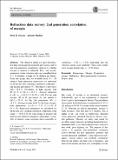Refraction data survey: 2nd generation correlation of myopia
Author(s)
Greene, Peter R.; Medina, Antonio
Download10792_2016_Article_172.pdf (795.6Kb)
OPEN_ACCESS_POLICY
Open Access Policy
Creative Commons Attribution-Noncommercial-Share Alike
Terms of use
Metadata
Show full item recordAbstract
The objective herein is to provide refraction data, myopia progression rate, prevalence, and 1st and 2nd generation correlations, relevant to whether myopia is random or inherited. First- and second-generation ocular refraction data are assembled from N = 34 families, average of 2.8 children per family. From this group, data are available from N = 165 subjects. Inter-generation regressions are performed on all the data sets, including correlation coefficient r, and myopia prevalence [%]. Prevalence of myopia is [M] = 38.5 %. Prevalence of high myopes with |R| >6 D is [M−] = 20.5 %. Average refraction is <R> = −1.84 D ± 3.22 (N = 165). For the high myopes, |R| >6 D, prevalence for the parents is [M−] = 25 %, for the 2nd generation [M−] = 16.5 %. Average myopia level for the high myopes, both generations, is <S> = −7.52 D ± 1.31 D (N = 33). Regression parameters are calculated for all the data sets, yielding correlation coefficients in the range r = 0.48–0.72 for some groups of myopes and high myopes, fathers to daughters, and mothers to sons. Also of interest, some categories show essentially no correlation, −0.20 < r < 0.20, indicating that the refractive errors occur randomly. Time series results show myopia diopter rates = −0.50 D/year.
Date issued
2016-01Department
Massachusetts Institute of Technology. Research Laboratory of ElectronicsJournal
International Ophthalmology
Publisher
Springer Netherlands
Citation
Greene, Peter R., and Antonio Medina. “Refraction Data Survey: 2nd Generation Correlation of Myopia.” Int Ophthalmol (January 12, 2016).
Version: Author's final manuscript
ISSN
0165-5701
1573-2630